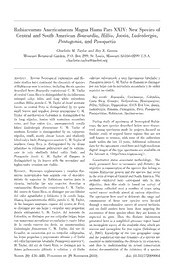
Rubiacearum Americanarum Magna Hama Pars XXIV: New Species of Central and South American Bouvardia, Hillia, Joosia, Ladenbergia, Pentagonia, and Posoqueria PDF
Preview Rubiacearum Americanarum Magna Hama Pars XXIV: New Species of Central and South American Bouvardia, Hillia, Joosia, Ladenbergia, Pentagonia, and Posoqueria
Rubiacearum Americanarum Magna Hama Pars XXIV: New Species of Central and South American Bouvardia, Hillia, Joosia, Ladenbergia, Pentagonia, and Posoqueria Charlotte M. Taylor and Roy E. Gereau Missouri Botanical Garden, P.0. Box 299, St. Louis, Missouri 63166-0299 U.S.A. [email protected] Abstract. Recent Neotropical exploration and Ho¬ calicino subtruncado a muy ligeramente lobulado; y listic studies have continued the discovery of species Posoqueria laevis C. M. Taylor de Panama se distingue of Rubiaceae new to science, including the six species described here: Bouvardia costaricensis C. M. Taylor superior no visible. of central Costa Rica is distinguished by its foliaceous fTecsomonarrlyeaaolslrloltlg srae l sedoi;an f Hv neccioaslel lrniytaahtxn rwp adule lmsosPttbeiieleprransuu l CeCia.ss on: M lddoJ. imo sToltboiasninyiaaggl o u iasri s nwohdtfhiei osiddttqwe iun bagiyrasuf an iimlastvsh eo eCrnqdf.tou ariMbnmtyee. LHPCoaoildssloetiaanq ,bu ReeHrriigicleialaai,ee, a,E PeRa,c nuuHaabimdipaopacr,oe, taPieHde,en eaStdaepy,ge ooIrtUmindiCaeacaN, oe Pc,R eeeraHudee,. nLPrioisqts,uo eJqozuioeesraiieaa,,, its long stipules, leaves with numerous secondary During study of specimens of Neotropical Rubia¬ lobes; Ladenbergia franciscana C. M. Taylor of ceae, the new species described below were discov- lsspootiiblupoetushdule elcrsoan,s l eys Cxmt oola silmvtla,eb l;muR tPoiicnesaotnl uytais sg o pobduntiubisaset ieson csgleaeuneaincsveshei essa, d nC ad.b n Myidt s. i sTtshsau aybldlltooerwnur snloye-f fwmddlaioeagtrldailit se aftk lio wncri o mittswhhtauenign d es tyspot h eooecsff ci mtlithaereseonnt pc tseiy1 c,pc5 aei wlt yesifedtpoha err hescmes.i rtmo eAsr eetdan gndsoidi ofta inhortshein g eatah hlv c-aarcoteio llsllaaeolbrecleulcte itto iinooononnnst Posoqueria laevis C. M. Taylor of Panama is the Internet at <http://www.tropicos.org>. distinguished by its leaves with the secondary and Conservation status assessment methodology. The higher-order venation not visible. study presented here is taxonomic and floristic: the Resumen. Recientes exploraciones y estudios flor- various Rubiaceae genera and the species that occur lsticos neotropicales han seguido eon el descubri- in the area of tropical Central and South America. The miento de especies de Rubiaceae methods employed here correspond only to this ciencia, incluidas las seis especies descritas a M. Taylor, specimens collected over a number of years using a de Costa Rica, se distingue p lobulos varied survey methods aimed at various objectives. orola larga, The specimens here used to delineate the range and blanca, hipocraterimorfa; Hillia pumila M. Taylor, commonness of these new species were located de los bosques o de Peru, ; distingue por sus hojas y estipulas muy pequenas; and no field studies have been done targeting the Joosia antioquiana C. M. Taylor, occurrence of these species where they are known or expected to grow. Thus the floristic information con numerosas nervaduras secundarias y cuatro lobos de la corola enteros (es decir, no ornamentados); on incomplete survey of the available data, which are Ladenbergia franciscana C. M. Taylor, del sur de uneven and incomplete for this region (Schulman et Ecuad< icteriza por su estipulas caliptradas, al., 2007). Knowledge of the true geographic range las hojas pequenas y mayormente obtusas y el limbo and the population size and dynamics of a species are del caliz ligeramente lobulado; Pentagonia osaensis C. and thus to understanding its actual conservation densa pubescencia pilosula a velutina y el limbo status; documentation ol the existence of a species Novon 20: 470-480. Published on 29 November 2010. doi: 10.3417/2009064 471 472 Novon stipules broadly triangular, 2-3 or 5 lobes with central lol elliptic to lanceolate. 12—15 X 7—8 mm, obtuse of uppermost leaves, 3- or acute, abaxially puberulous; anthers narrowly elli cymose; peduncles 10-25 ir soid, ca. 5 mm, included with tips positioned < 2-3 7 mm, exserted by 10-15 mm from corolla tul Immature fruit subglobose, 7-8 X 10-12 m essentially to base, lobes 4, elliptic to lanceolate, 20- laterally s flattened, with calyx lobes 25 X 8-11 mm, acute to shortly acuminate, costate persistent. 473 477 of P.
